Hawk’s sportive lemur
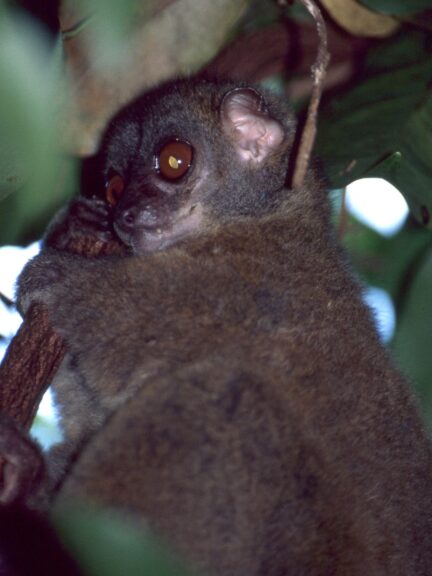
The Hawk’s sportive lemur is a weasel lemur found in the Lokobe area and on the island of Nosy Be in Madagascar. This species is most closely related to L. milanoii, L. ankaranensis, the gray-backed weasel (L. dorsalis) and L. sahamalazensis, which are also the closest. This species is named after Howard and Rhonda Hawk, who provided much support for the research that led to the description of this species.
Hawk’s sportive lemur is a medium-sized weasel lemur. The weight is 0.88 kg. The back is brown-grey, the underside light-grey. A dark brown to black stripe runs across the top of the head and body. The face is gray. The tail is reddish gray to brown.
Claire’s mouse lemur
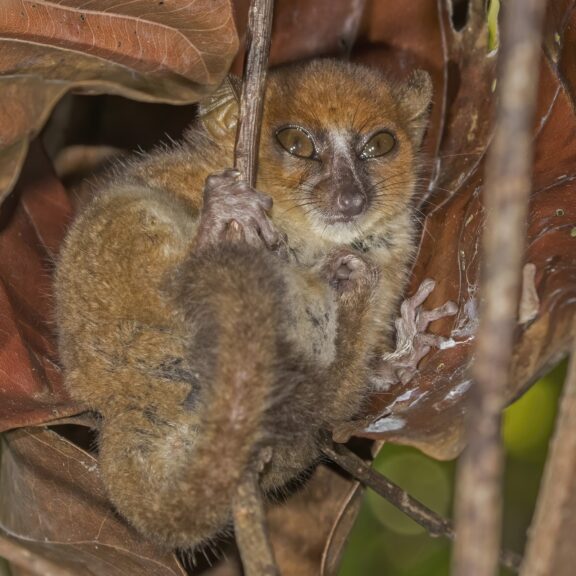
Claire’s mouse lemur is a lemur of the genus of mouse lemurs found on the island of Nosy Bé in the Antsiranana province of Madagascar. The scientific specific name, mamiratra, comes from Malagasy and means “clear and bright”.
This mouse lemur is most closely related to an undescribed species from mainland Madagascar; this group is related to either M. tavaratra or M. sambiranensis.
This lemur, weighing about 61 grams, is medium-sized for its genus. The head-body length is 117 to 129 millimeters, the tail length 147 to 169 millimeters. The short, dense coat is reddish brown on top and lightens towards the center of the back. The underside is white to cream colored. On the front part of the beak is a white stripe, which becomes wider and more diffuse between the eyes. Like the body, the tail is reddish brown. Some specimens have a grey-brown dorsal stripe. The sparsely furred hands and feet are gray or white.
Black lemur
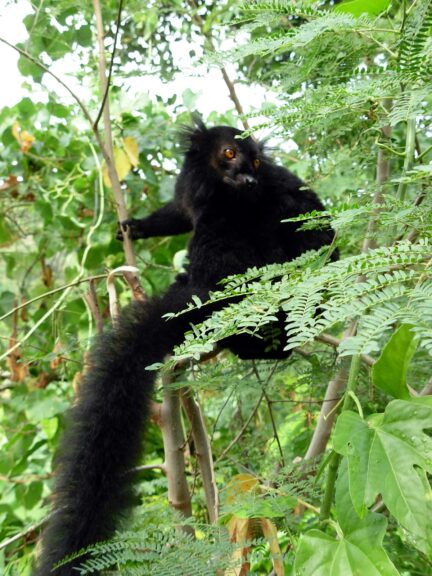
The black lemur or black lemur (Eulemur macaco) is a true lemur from the lemur family (Lemuridae). They are endemic animals on the island of Madagascar and can be found on Nosy Be.
There is a clear difference between the male and the female. The male has a black coat, in which a reddish-brown sheen can be seen in a certain lighting. There are striking tufts of hair on the ears. The female has brown fur on the back and is lighter brown to almost gray white underneath. The tufts of hair near the ears are white in color in the female. Both sexes have a remarkably long and furry tail. The eyes are orange-yellow, which makes it different from the blue-eyed lemur. An adult black lemur has a head-torso length of 39 to 45 cm, a tail length of 51 to 65 cm and a body weight of 1.8 to 2.0 kg.
The black lemur lives in northwestern Madagascar and the nearby islands of Nosy Be, Nosy Komba and Nosy Tanikely. The black lemur occurs in a number of landscape types such as primary rainforest, but it can also adapt to cleared forest, areas consisting of a mosaic of farmland and secondary forest and to production forest at an altitude of zero to 1600 m above sea level. .
The black lemur lives in family groups, consisting of 2 to 15 individuals. The black lemur is vulnerable due to the destruction of its habitat by slash-and-burn. It is also hunted for meat and there is a small-scale but ineradicable (illegal) trade in live squirrel lemurs as pets, especially on the island of Nosy Be. The black lemur is therefore listed as vulnerable on the international red list.
Panther Chameleon
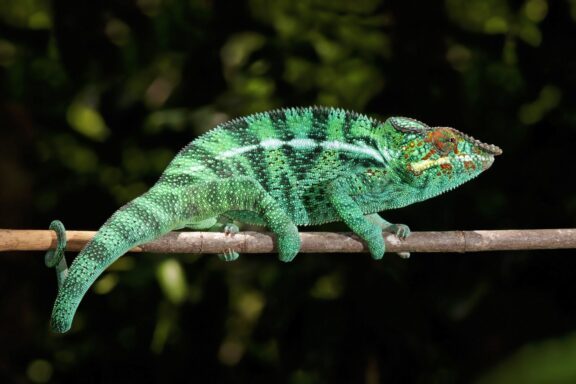
Another famous inhabitant of Nosy Be is the Panther chameleon. The male panther chameleon can grow to more than fifty centimeters in length, but the female and captive specimens usually stay under forty centimeters. On the flank, a single stripe runs from head to tail and usually a number of dark spots or stripes on the flanks and legs, which gives the name. The species can be recognized by its somewhat elongated body, spiky back comb (male) and round, long tail. The chameleon also has a throat pouch that is set up to make the head appear larger.
The colors are often specific to the region where the animal comes from. The region name is therefore used in addition to the species name to indicate from which area the animal, and the associated color line, originates. For example, a color line that comes from the island of Mitsio is called “Furcifer Pardalis Nosy Mitsio”. The panther chameleon has a lot of color variants, really all colors are represented. Every animal has a limited palette of colors with which it can change its appearance. Such a color palette is generally composed of the colors that are also visible at rest.
When excited, they will show these colors more intensely, whereby the pattern of the animal remains almost the same but becomes much more clearly visible. They therefore become more intense in color and will not suddenly turn from blue to orange and then to purple again. This change is not, as is generally believed, to adapt to one’s environment, but has to do with mood. In general, only the male has strikingly variegated colors. The females are often somewhat light brown/pink in color, making it particularly difficult to recognize from which region they come.
The panther chameleon is a real climber that rarely reaches the bottom. The food consists of insects and other small animals, this species also sometimes wants to catch small birds or lizards. Chameleons are known to change color for camouflage, but these discolorations are also important in communication, for example to attract females. Females that are already fertilized indicate that they are not prepared to mate.
A clutch consists of twelve to fifty eggs, which are deposited and buried in moist soil. The males fight for territories during the breeding season.
Like the carpet chameleon (Furcifer lateralis), this species is endemic to Madagascar and some small surrounding islands. The habitat consists of dry and humid tropical and subtropical forests and scrublands. The species also occurs in man-made areas such as gardens and plantations.
Due to the fragmented habitat, different color variants have arisen that are not considered as separate subspecies but as color variations. The panther chameleon also occurs in Mauritius and Réunion, but it was deliberately released there. It seems that this species can quickly adapt to cultivated landscapes, driving out other species and the panther chameleon, on the contrary, spreading. The lizard lives in shrubs and trees in moist forest areas. The species has been found from sea level to an altitude of about 950 meters above sea level.
Madagascar Fish Eagle

The Madagascar White-tailed Eagle (Haliaeetus vociferoides) is a bird of prey and a critically endangered endemic bird species from Madagascar, which can be seen in Nosy Be.
The bird is 70 to 80 cm long. It is a large species of sea eagle. The bird is predominantly dark reddish brown, the crown is dark brown while the “cheeks” and throat are on the other hand light, almost white. The tail is short and white. Immature birds have a dark tail and are mottled brown. The bird hunts low over the water and can sit still for hours in a large tree.
This species occurs on the western side of Madagascar. The habitat consists of a combination of large bodies of water such as lakes or the sea with wooded areas in which there are mainly large trees.
The Madagascar sea eagle has a very small distribution area and therefore the risk of extinction is present. The population size was estimated at 240 mature individuals by BirdLife International in 2016 and population numbers are decreasing. The habitat is threatened by deforestation and the cultivation of rice in coastal areas. In addition, the bird is still regarded as a competitor for fishing and is therefore sometimes prosecuted. For these reasons, this species is listed as critically endangered (critical) on the IUCN Red List.
Malagasy paradise flycatcher

The Malagasy paradise flycatcher (Terpsiphone mutata) is a bird found in Comoros, Madagascar, and Mayotte. Its natural habitats are subtropical or tropical dry forest and subtropical or tropical moist lowland forest. We can find him in Nosy Be.
The Malagasy paradise flycatcher is thought to have evolved from African ancestors, as it appears to be more closely related to the African paradise flycatcher than the Indian paradise flycatcher. There are five subspecies recognized, which differ only slightly in appearance:
The Malagasy paradise flycatcher is a medium-sized passerine, measuring 18 cm in length and weighing between 12.1 and 12.3 g . Males have long tail plumes, which can add as much as 18 cm to their overall length. The female is largely rufous-orange, with a black head and nape. The flight feathers on her wings are black with rufous edges, and she has a thin, light blue eyelid wattle.
This species is a regional endemic found on Madagascar, Mayotte and the Comoros islands. It is common in all native forest types except montane forest, at elevations ranging from sea level to 1,600 m. It also occurs, though less frequently, in other wooded habitats, including plantations, gardens and secondary forest.
Like all members of its genus, the Malagasy paradise flycatcher is an insectivore, feeding on a variety of insects. It regularly joins mixed-species flocks, particularly those containing common newtonias. It is a “follower” in such flocks, allowing other birds to work as “beaters”; it follows them and hunts down any insect prey they flush. Studies have shown that the paradise flycatcher’s foraging efficiency is directly correlated to the number of common newtonia in a flock; a greater number of common newtonias results in a higher foraging efficiency for any accompanying Malagasy paradise flycatchers. When rufous vangas, which generally forage within a meter or so of the ground, are present in the same mixed-species flocks as Malagasy paradise flycatchers, the latter preferentially follow the vangas, and therefore forage closer to the ground than they normally do.
Humpback whales
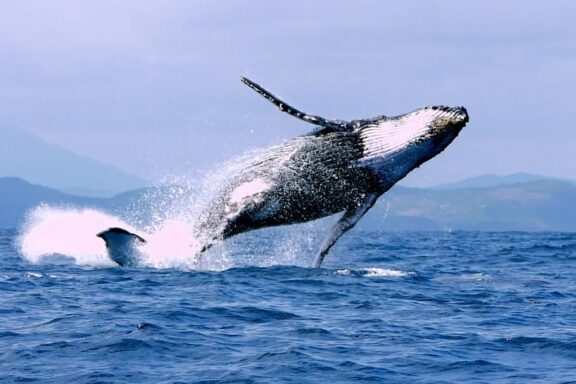
The humpback whale travels between the fish-rich waters of the poles to feed on krill and warmer tropical waters to reproduce. Mother-calf couples can be seen in shallow waters in the bay between Madagascar mainland and Nosy Be, where we can also see males fight and humpback whales jump.
The first humpback whales appear near Nosy Be in July and leave in November, with August to October being the high season and September usually the top month.
In tropical areas male humpback whales sing to seduce females. Some songs are shared and repeated by all whales in the same area! They can measure up to 15 meters and weigh 40 tons. They mostly eat krill when they are in the pole regions, so when they are in Nosy Be they don’t eat.
Indo Pacific bottlenose dolphin

The Indo Pacific bottlenose dolphin can be found all around the world and they are in the waters around Nosy Be year round, mostly in groups up to 30 – 40 individuals. If you’re lucky you can see them jumping from your boat.
Dolphins can dive really deep to the bottom of the ocean where they are hunting fish and squid. They can be up to three meters, 200 kg and live 35 years. This species is known to be very playful and even use shells to play and use tools such as sponges. In Mayotte dolphins have even seen playing with pufferfish.
Whale shark
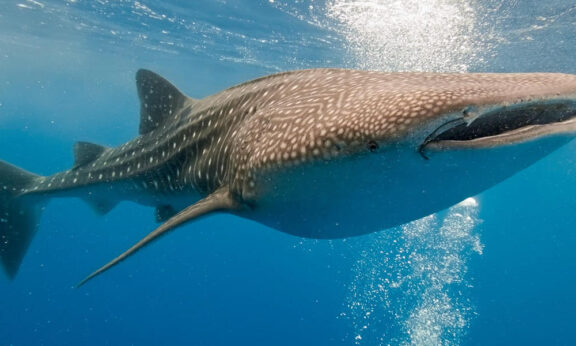
The whale shark is the largest fish in the world and can be as long as fifteen meters. We can also observe them at Nosy Be, where they come to feed on plankton, krill, fish eggs and similar. They are present near Nosy Be between September and December, October and November being the top season, and can often be seen on the surface where they come to feed. Sharks can dive to almost 2 kilometers deep, so they probably descend deep in the open sea to find food as well, thanks to their thick skin (30 cm!).
Spinner dolphins
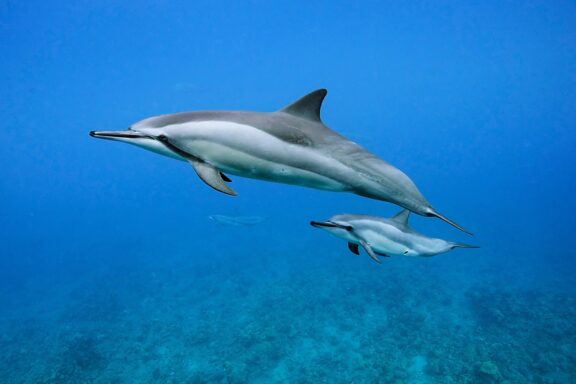
Spinner dolphins can often be seen near Nosy Be in groups of 50 to 300 individuals, but groups over 1.000 spinner dolphins have been recorded. They are not too big with only 170 – 190 cm and weigh around 80 kg. They are playful and more social than bottlenose dolphins and sometimes even approach boats to put on a show. They stay near Nosy Be the whole year so there is a big chance you will see them when you’re on a boat ride to Nosy Komba or Nosy Tanikely or other.
Unlike humpback whales and whale sharks they hunt on small fish like lantern fish which they go search more than 200 meters deep at night as the lantern fish come up at night to hunt for plankton. It is possible you will see the spinner dolphins among other kinds of dolphins or humpback whales while you are going on a whale watching tour or even on your boat transfer to one of the islands near Nosy Be.
Omura whale

Omura whales are mostly between 9 and 12 meters, so they are quite small for a whale. They are shy compared to other whales and dolphins, but they can be seen on the surface during the right months on the west coast of Madagascar and Nosy Be where they come to feed and reproduce and can be seen the whole year in Nosy Be.
Pilot whale
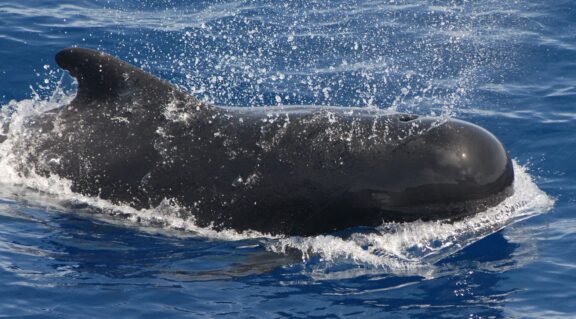
The pilot whale is part of the dolphin family and can be found all around the world. They are very social and can be found among other groups of dolphins and they are not shy among boats, so we can often approach them and look at their jumps and strikes. We can see pilot whales the whole year around Nosy Be and you don’t necessarily need to go on a whale watching tour as you sometimes can see them from your boat transfer or during a trip to one of the smaller islands. Pilot whales eat a wide variety of fish, octopus and squid. Males are between 5.5 and 6.4 meters and can weigh up to 3.5 tons. Females are a bit smaller with 4.5 to 5.5 m and will often not succeed 2.5 tons.
Pantropical spotted dolphin

The pantropical spotted dolphin can be found in tropical waters around the world and is very common in Nosy Be where they can be seen year round. The pantropical spotted dolphin can be identified by its spotted belly and flanks. They can be in groups of over 500 individuals! They are social animals which love to play and they often approach boats to put on a show. There is a chance you will see them on a whale watching tour or during island hopping from Nosy Be to one of the smaller islands. They eat several kinds of fish and squid and sometimes hunt together with other dolphin species, birds and game fish. They grow up to around two meters and weigh around 120 kilos.
False killer whale
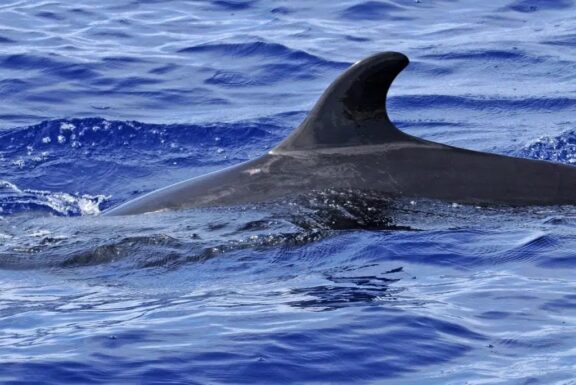
The false killer whale is actually part of the dolphin family and looks like something between a dolphin and an orca with its head resembling that of a killer whale. They can be seen in small groups of just a few members, but can also be in groups of hundreds of false killer whales. They sometimes tend to follow boats and you can see them jump behind the boat. You can see false killer whales year round near Nosy Be and mostly in the deeper waters and they are sometimes present during boat transfers between the islands or we can see them during our whale watching excursions. They eat squid, octopus, various fish, but also attack large mammals like dolphins and birds. They are also known to steal fish from fishing lines and nets or even steal the prey from other dolphins. They are very big compared to other dolphins and can be up to six meters and weigh one ton. No surprise they are called false killer whales!
Humpback dolphin
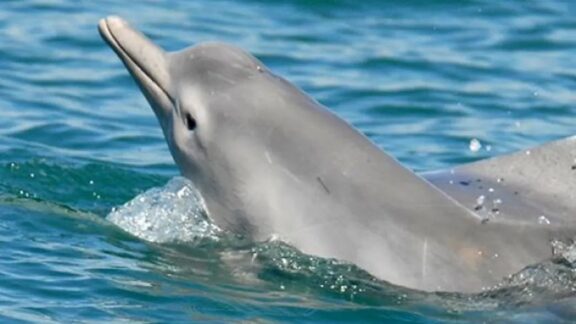
Humpback dolphins can be identified by their hump in front of the dorsal fin. We can see them in shallow waters in groups of up to fifteen members. Unlike other dolphins they are quite shy and not easy to approach. Just like other dolphins they are great at acrobatics and jumping. We can see them year round near Nosy Be and it’s not uncommon to spot them as they stay close near the coast. They reach up to three meters and can easily weigh 300 kg or more and we can often see them together with bottlenose dolphins.
Manta Ray
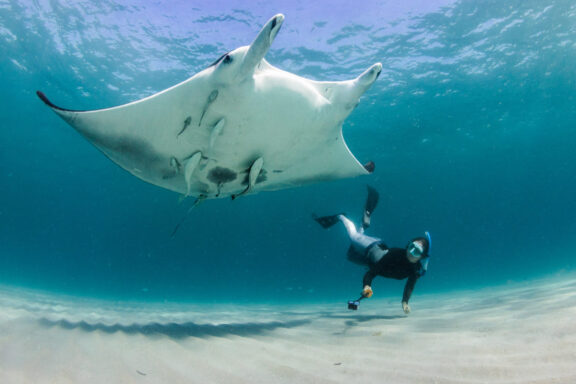
Manta rays found in tropical waters around the world and sometimes even up north. At Nosy Be they are usually seen near the surface and don’t go really deep so scuba divers and snorkelers have a good chance of seeing them near coral reefs. Rays can be a big as 7 m (left to right) and weighing up to 2 – 3 tons. They mostly feed on plankton and small fish
Hawksbill turtles
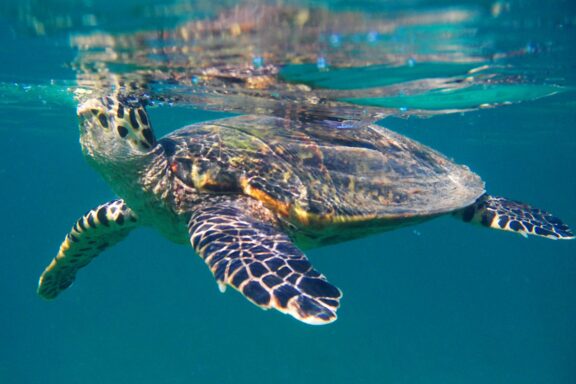
The hawksbill turtle is easily identifiable by its thick scales which look like tiles of a roof and his small hooked beak. We can find them in tropical seas near the coast and they are unfortunately threatened as their shells are in high demand.
We can find hawksbill turtles near the reefs around Nosy Be, especially in Nosy Tanikely where you can see them during snorkeling trip. These turtles vary between 60 cm and 100 cm and can weigh up to 75 kg. They mostly feed on jellyfish and sponges. Every two – three years they reproduce during a six month breeding period. Nests are made in the sand on the beach and can contain hundreds of eggs.
Green turtles
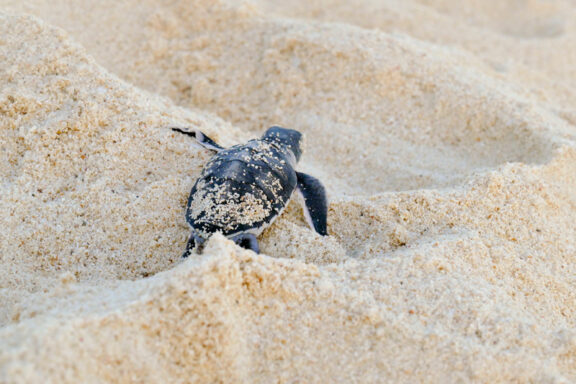
Green turtles have a yellow – brown shell, but their skin is green. They can be 1.5 meters long and weigh over 300 kilos. They have a big head and are the fastest sea turtles in the world. Males can be distinguished by their large tails. Green turtles can be seen at all times near Nosy Be. They mostly feed around Nosy Sakatia and breed at Nosy Iranja. They mostly eat sea grass, but also some invertebrates and fish eggs. The female turtles lay hundreds of eggs at a time, every two or three years, and will always come back to lay eggs on the beach where they were born. They can live up to 100 years!













